Can Hamsters Eat Cabbage? The Expert Veterinary Guide to Safe Serving, Portions, and Risks
Can Hamsters Eat Cabbage? Yes, hamsters can safely eat cabbage, provided it is given in strictly controlled, very small amounts as an occasional treat. Cabbage, alongside other vegetables like broccoli and cauliflower, is confirmed as a suitable fresh food supplement for hamsters by major organizations.
However, due to inherent risks, including high fiber and water content which can lead to rapid onset diarrhea and bloat, and the potential for chronic conditions like urolithiasis, feeding must be rationed severely. The maximum safe portion is the size of a human thumbnail, offered once per week, maximum.
The Significance of A Balanced Diet For Hamsters and the Role of Cabbage
Hamsters, like all other pets, require a balanced diet for their growth, development, and overall well-being. Along with numerous other healthy options, vegetables are essential for hamsters as they provide vitamins, minerals, and fiber. Additionally, they help hamsters keep their immune systems strong and support their digestive health.
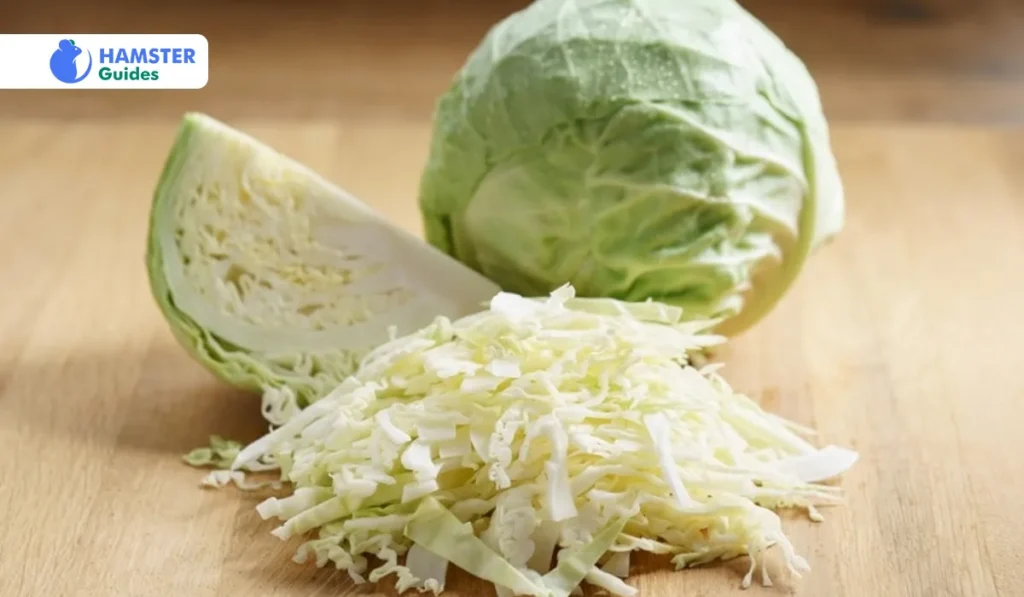
One vegetable that is often debated is cabbage. Hamster owners usually ask: Can hamsters eat cabbage? Remember that cabbage is a nutrient-rich vegetable with a good amount of Vitamin C, K, and fiber, providing numerous health benefits. However, if over-consumed, cabbage contains a compound called goitrogen that interferes with thyroid function.
Therefore, moderation is key when feeding cabbage to your little chewy friend.
Nutritional Risk and Safety Quantification
Before serving, preparation is crucial to ensure the cabbage is safe and non-abrasive. All fresh produce must be thoroughly washed to eliminate any pesticides, bacteria, or environmental contaminants. Once cleaned, the structural integrity of the cabbage leaf must be considered relative to the hamster’s cheek pouches.
Hamsters store food in these pouches, and abrasive or sharp pieces can cause injury, inflammation, or impaction. Therefore, the cabbage should be cut into thin strips or small, non-stringy cubes. Due to the high water content, only a single, thumbnail-sized piece is appropriate for a weekly treat.
Cabbage’s Nutritional Profile
Incorporating cabbage into your hamster’s diet plan can give them several nutrients required for their health and overall well-being.

Here is a table of approximate values of the nutrients that cabbage contains:
| Nutrient | Amount per 100g |
| Vitamin C | 36.6mg |
| Vitamin K | 76microg |
| Manganese | 0.160mg |
| Potassium | 170mg |
| Magnesium | 12mg |
| Fibre | 2.5g |
| Vitamin C | 32.6mg |
| Sugar | 2.9g |
| Calories | 22 |
| Carbohydrate | 5.2g |
Nutritional Benefits of Cabbage
The leafy green vegetable cabbage belongs to the Brassica family. As with other vegetables in the family, such as cauliflower, broccoli, and kale, cabbage is low in calories but high in nutrients.
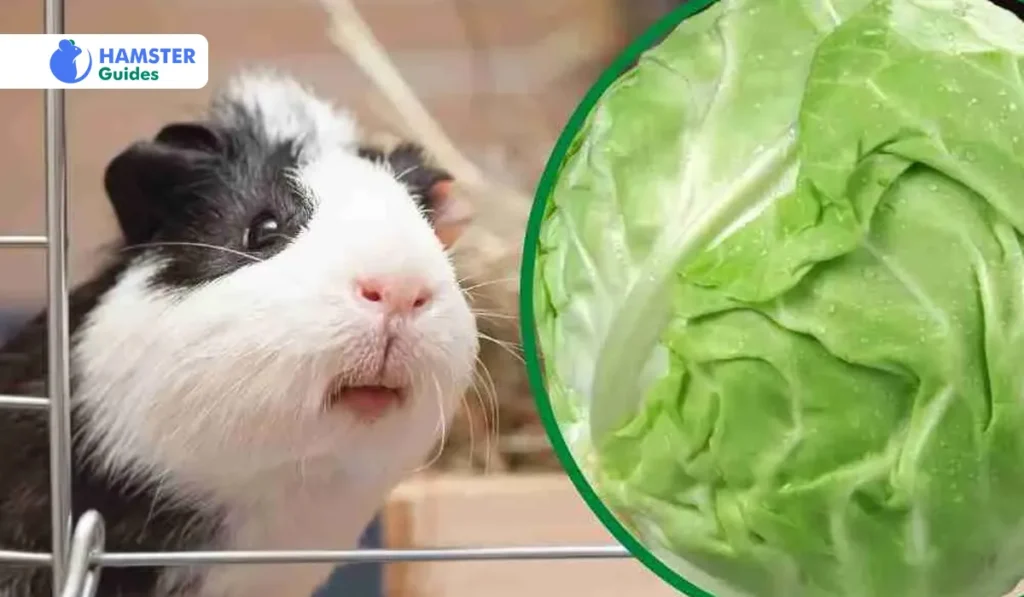
That’s what makes it a perfect choice for your hamsters. Moreover, cabbage is beneficial in several ways, as mentioned below:
Cabbage is a nutrient-dense vegetable that provides your furry friends with numerous minerals, vitamins, and fiber that help them stay healthy and thrive.
Read More: How To Take Care Of A Hamster?
How Much Cabbage Can Hamsters Handle?
As with all other fruits and vegetables, moderation is the key when it comes to feeding cabbage to your little fuzzy friend. While cabbage provides numerous nutrients, feeding it in excess can lead to several health issues, such as digestive problems or thyroid issues.
Overfeeding fresh produce, even generally safe vegetables, is the most common cause of digestive illness in hamsters. The appropriate serving size for cabbage must be highly restrictive.
The maximum safe portion is generally recommended to be no larger than the size of a human thumbnail or the hamster’s own ear. This limit applies to the total fresh food allowance for that feeding. The frequency for cabbage must be limited to once per week, maximum.
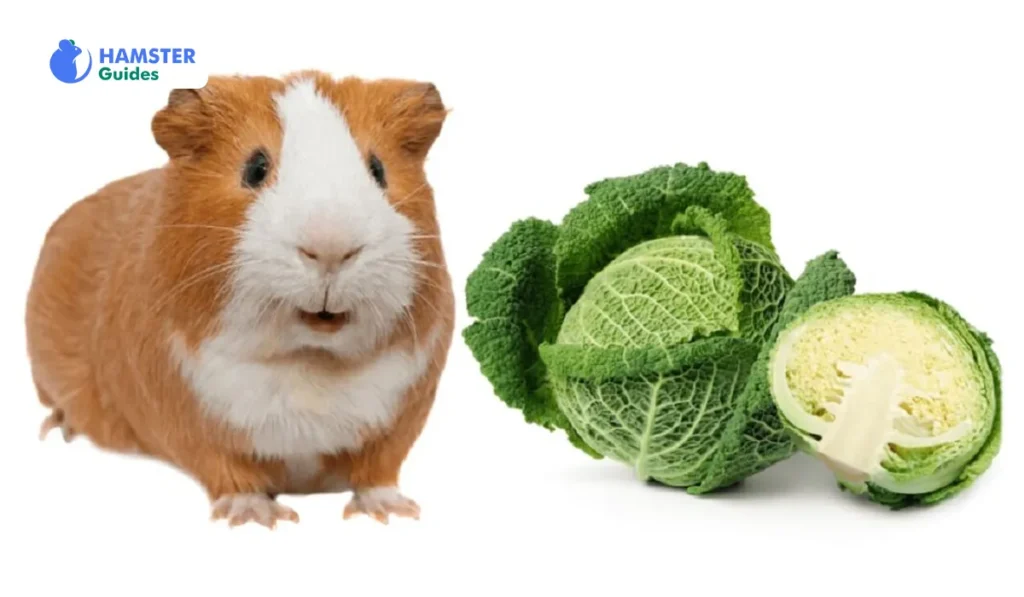
Therefore, it is far better to introduce cabbage in small, bite-sized portions, gradually, and monitor their reaction. Additionally, they offer cabbage and other fruits, vegetables, grains, and protein to ensure they get various nutrients.
PractiCing portion control and offering a balanced diet can help your hamsters stay healthy and happy. Moreover, it is also crucial to regularly provide them with fresh and clean water.
Recommended Diet
When feeding cabbage to your little fuzzy friend, here is a chart of recommended diets for hamsters
| Hamster | Amount of Cabbage | Frequency |
| Dwarf Hamsters | 1-2 small leaves | Once or twice a week |
| Syrian Hamsters | 2-3 small leaves | Once or twice a week |
| Roborovski Hamsters | 1 small leaf | Once a week |
Special Consideration for Dwarf Hamsters
Dwarf hamsters (such as Roborovski, Winter White, and Campbell’s) possess highly sensitive digestive systems and, depending on the species, can be prone to sugar-related issues like diabetes.
While purple/red cabbage is safe, the overall sensitivity of dwarf systems means that any new food must be introduced slowly and observed carefully for any sign of diarrhea or adverse reaction.
Can Dwarf Hamsters Eat Red Cabbage?
When talking about cabbage, another question that looms over your head is, “Can hamsters have red cabbage?” While hamsters can eat red cabbage, ensure they are fed in moderation. Since red cabbage, like green cabbage, offers various nutrient benefits, it also contains some potential health risks.
Hamster owners usually ask, “Can hamsters eat raw red cabbage? Rest assured, they can. However, wash raw cabbage thoroughly and cut it into small, manageable pieces. Moreover, As with all new foods, introduce cabbage gradually and observe the reaction. If your pet shows any sign of discomfort, stop feeding immediately and consult a vet.
Can Dwarf Hamsters Eat Purple Cabbage?
Purple cabbage, also known as red cabbage, is safe for dwarf hamsters. Since they contain numerous essential vitamins, minerals, and antioxidants, they can be an excellent addition to dwarf hamsters’ diets. However, it is necessary to introduce cabbage gradually and in small amounts.

Additionally, dwarf hamsters’ reactions should be monitored to ensure they can tolerate it well and not experience digestion problems.
Further Exploring Cabbage: Leaves, Stalks, and Seeds
The hoarding behavior of hamsters necessitates diligent removal of fresh food. Because fresh vegetables are highly susceptible to mold and bacterial contamination, which can cause severe illness, any uneaten cabbage must be located and removed from the habitat daily, ideally within hours of feeding.
Cabbage is a popular choice among hamster owners. However, when it comes to feeding cabbage to your little hammy, hamster owners wonder about feeding its various parts. Let’s explore whether hamsters can eat cabbage leaves, stalks, and seeds.
Can Hamsters Eat Cabbage Leaves?
Yes, introducing cabbage leaves can be a healthy choice for hamsters. However, ensure that leaves are washed thoroughly and pesticides are removed. Moreover, it is wise to introduce small amounts of chopped leaves to avoid choking hazards.

Can Hamsters Eat Cabbage Stalks?
Hamsters can also enjoy cabbage stalks. However, cabbage stalks are tougher for hamsters to consume, so cut them into manageable, bite-sized pieces and offer them to your hamsters in moderation.
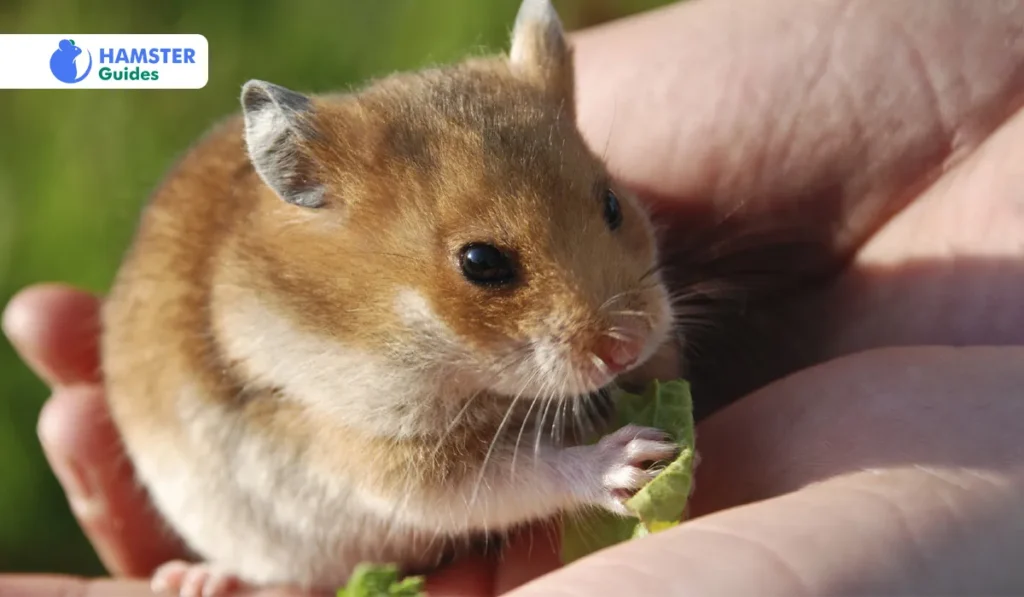
Can Hamsters Eat Cabbage Seeds?
It is wise to avoid cabbage seeds. These are not harmful and do not have any nutritional value. Instead, stick to feeding cabbage leaves and stalks to ensure a healthy, balanced diet.
Dark Side of Cabbage: Some Risks Associated With Cabbage
Feeding cabbage to your little chewy hammy can prove dangerous if it is overfed. To keep your hamsters happy and growing, it is essential to be aware of the potential dangers of cabbage.

Risk 1: Acute Gastrointestinal Upset (Water and Fiber Load)
The most immediate danger is the potential for acute gastrointestinal distress. Cabbage contains a high percentage of both water and indigestible fiber. Oligosaccharides, complex sugars found in cabbage, can become difficult for hamsters to digest.
If they reach the large intestine undigested, these sugars can incite trouble and produce gas. This gas can eventually cause bloating and discomfort and make hamsters feel lethargic. Ingesting too much rapidly overwhelms the hamster’s delicate digestive flora, leading to an immediate acceleration of gut motility.
The result is excess gas, bloating, and diarrhea. This fluid loss can quickly lead to life-threatening dehydration, which can manifest as the syndrome commonly referred to as Wet Tail. This rapid onset, potentially fatal risk is the primary reason the portion must be strictly monitored to a thumbnail size.
Risk 2: Chronic Thyroid Concerns (Goitrogens)
Cabbage belongs to the family of cruciferous vegetables which contain goitrogenic compounds. Goitrogens interfere with the absorption and utilization of iodine, which is necessary for the production of thyroid hormones.
In high, chronic doses, this interference can lead to an enlargement of the thyroid gland, known as a goiter. This risk is managed effectively by ensuring the staple diet is a high-quality commercial pellet or mixture formulated to meet complete nutritional needs.
Since these commercial feeds provide a balanced iodine intake, the occasional, small serving of cabbage is highly unlikely to cause a thyroid issue; however, owners should limit the total intake of all cruciferous vegetables.
Risk 3: Urolithiasis Risk (Oxalate Content and Kidney Stones
Cabbage is classified as a high-oxalate food. Oxalates are organic compounds that, when consumed in excess, can bind with calcium and other minerals, contributing to the formation of urinary stones.
Urolithiasis, or the presence of stones in the urinary tract, is a recognized and recurrent disease in hamsters, and treatment protocols often involve dietary management focused on avoiding mineral salt and oxalate excess.
The strict, once-weekly limitation on cabbage (and other high-oxalate greens like spinach ) is vital for preventing the cumulative buildup of oxalates that predisposes the animal to urolithiasis.
Additional Information: Inorganic cabbage is sprayed with numerous chemicals, and hamsters struggle to cope with these toxins. Therefore, it is better to offer only organic cabbage to your hamsters.
The Right Diet is Crucial: Hamster-Specific Considerations
Wild hamsters love to enjoy an omnivorous diet, including insects, worms, seeds, and plants.

Therefore, besides eating leafy greens such as cabbage, here is what you can offer to your hamster:
Read More: How To Take Care Of A Hamster?
Safe Alternatives and Absolute Toxin Index
For owners looking to provide variety, many other vegetables are safe and highly recommended supplements. These should still be offered in similarly small, thumbnail-sized portions once per day as part of the fresh food allowance.
Safe and Recommended Alternatives include: Broccoli, Cauliflower, Chicory, Cucumber, Romaine Lettuce, Zucchini, Parsnips, and Green Beans (with strings removed). Note that high-sugar vegetables, such as carrots, must be treated as strict treats and heavily rationed due to their high natural sugar content.
The Hamster Toxin Index: Foods Never to Feed
Certain foods must be strictly avoided as they are toxic or pose significant mechanical or acidic risks to the hamster’s sensitive system. Foods to avoid include: Grapes & Rhubarb (poisonous to rodents ), Citrus Fruits (too acidic ), Onions/Garlic/Chives/Leeks (toxic to the blood ), Avocado (contains toxic compounds ), and Raw Potatoes (contain toxic Solanine ).
Final Thoughts
Cabbage is a nutrient-dense option that can benefit your hamster’s diet, but only when treated as a supplementary treat. By following the strict guidelines specifically the thumbnail-sized portion, once-per-week frequency, and careful preparation you can safely offer this vegetable while mitigating the serious risks of acute gastrointestinal upset and chronic metabolic issues like urolithiasis. Always monitor your hamster’s reaction to any new food and remove uneaten fresh food daily.
Hope your hamster enjoys its meal!







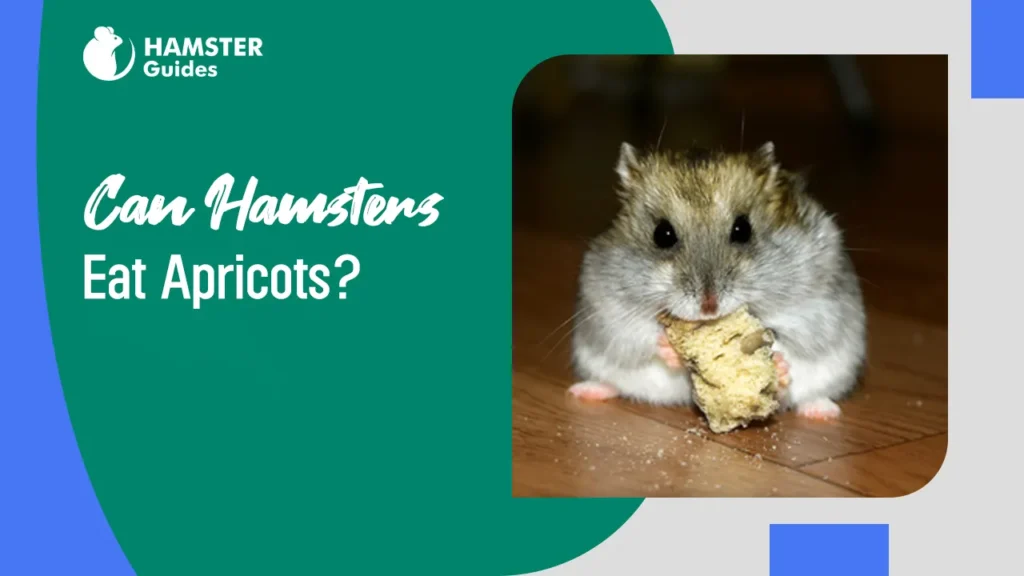

Leave a Reply